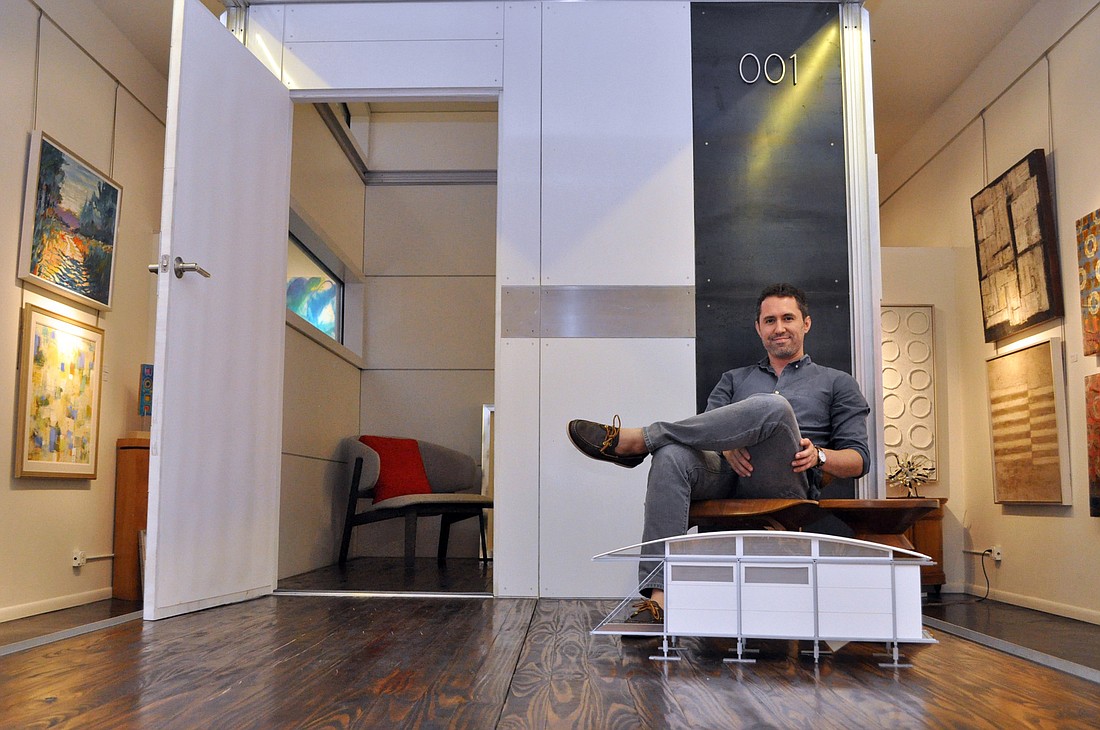- November 25, 2024
-
-
Loading

Loading

Currently on display at State of the Arts gallery is a piece unlike any other the gallery has ever hosted — a portable housing unit. The structure, which is posing as a work of art on display, is the prototype of a patent-pending disaster relief portable dwelling, AbleNook, designed by Sean Verdecia and Jason Ross, who developed and created the concept while in architect school at USF.
Verdecia, a Tampa native, has been working with local architect Jonathan Parks and decided to deploy the prototype in Sarasota.
“It’s something so different than we’ve done before, but instantly after meeting him, it felt right,” says owner Tre Michel.
How it came together
The idea came about when they saw the devastation of Hurricane Katrina, but it wasn’t until 2010 that Verdecia and Ross decided to get their idea rolling. With architecture school and other obligations, it was going to be hard to find the time to design and bring the concept to life. The only way they could manage was to turn the idea into a four-credit class. They began the project in an independent study course.
What they came up with is what is now the AbleNook — a multi-use portable dwelling, which is easily portable and assembled. Proof being, Verdecia, Parks and a few helping hands assembled the module inside State of the Arts, with only rubber mallets.
Verdecia and Ross’s independent study instructor, Mark Weston, suggested to the two that they get their idea patented.
“We went in, looking like college students, dressed in shorts — not looking like we were about to be taken seriously. Eventually, by the end of our pitch, the guy stopped rocking back and forth in his chair and was all ears,” says Verdecia.
Verdecia and Ross were given $12,000 to make to make the curved roof and a few of the connecting members. Feeling as though people wouldn’t get the full visual understanding if the project weren’t completed, they complied all of the funds they had, plus some future paychecks, and funded the rest of the project by themselves.
“I actually learned so much about architecture through this. In school, you learn a lot about theory and how one feels when they move through a structure, but the nuts and bolts of it all, I figured out during this project," says Verdecia. "Each piece was a treasure hunt. Finding materials in the budget, figuring out what we could use off the shelf, what we would have to customize, it was all a learning process.”
A closer look
The design, which is as aesthetically pleasing as functional, was designed to be just that.
“The design really is, pure functional. I feel that the more functional the design, the more beautiful — it’s an expression of it’s functionality,” says Verdecia. Using the Japanese Zen theory of design, they simplified the design, leaving it entirely with only the pieces that matter.
The curved roof is the modules signature look, which designed that way for two reasons. One being that the strength of an arch is unbeatable and two, for its more femininity The base of the module has more masculine lines. To create unity of the different sides of the structure, the curved roof was an element to make that balance.
The front porches on the front of the modules are a mandatory design aspect, bringing in sense of community. “It’s integral for disaster relief, to create that sense of togetherness,” says Verdecia.
The basics of the module include air conditioning, lights that are activated when certain pieces of the structure are connected and outlets. The mechanical parts, including the air conditioning are all in the back of the unit, in an option bay type area, which can be used according to the specific means of the occupant. When broken down, the structure fits in the bed of an eight-foot truck bed.
Currently, the Able Nook is being sold at attainable prices, per person, per package. The ultimate goal for the modules to be hut approved to go into mass areas is still in the works.
“There’s a lot of tooling to still be made. It’s been a long road. Anything you create, it’s like a child – getting it ready to just send it on its way, sending it out to the wolves. You have to make sure it’s ready,” says Verdecia, “Ultimately, it’s a passion project.”
The Able Nook, which was assembled Saturday, Aug. 24, will be on display at State of the Arts Gallery for another two weeks.
For more information, visit www.ablenook.com